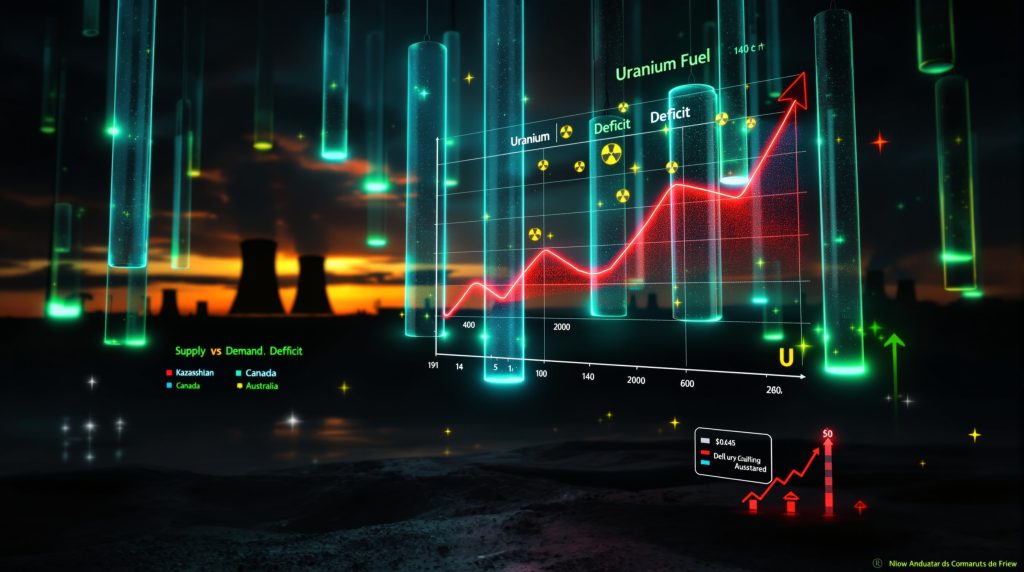The Growing Uranium Supply Deficit: Causes, Impacts, and Future Outlook
Fundamental Supply-Demand Imbalance
The global uranium market is currently experiencing a significant structural deficit, with annual consumption exceeding primary production by approximately 50 million pounds. Current reactor demand requires roughly 180 million pounds annually, while mines worldwide produce only about 130 million pounds. This 28% shortfall represents one of the largest commodity supply deficits in the energy sector and continues to widen as nuclear power expands globally.
According to the World Nuclear Association's 2024 Nuclear Fuel Report, global uranium requirements are projected to increase from approximately 65,650 tonnes U (172 million pounds U₃O₈) in 2024 to over 100,000 tonnes U by 2040. The International Atomic Energy Agency (IAEA) reported in their 2023 "Uranium 2023: Resources, Production and Demand" that world uranium production in 2022 was 49,355 tonnes U, significantly below reactor requirements.
Legacy of Price-Driven Underinvestment
The current deficit stems largely from a decade of suppressed uranium prices between 2011-2020, when spot prices hovered around $20-30 per pound—well below the $60-80 production costs for many operations. This prolonged period of uneconomic pricing led to severe industry contraction:
- Closure of major mines including Ranger in Australia (which ceased operations in 2021 after 40 years of production)
- Shutdown of the Cominak mine in Niger in 2021
- Cancellation or indefinite delay of development projects
- Minimal exploration for new deposits
- Reduced capital investment in existing operations
This decade-long investment drought created a substantial gap in the development pipeline that cannot be quickly remedied, even with today's improved market conditions.
Production Concentration Risks
The market faces significant supply concentration challenges that amplify the deficit risks:
- Kazakhstan accounts for approximately 43% of global uranium production as of 2023
- Just 10 mines account for over 70% of worldwide production
- Over 80% of uranium comes from just five countries
This concentration creates vulnerability to disruptions at key production centers, as evidenced by recent production challenges in Kazakhstan and Niger. Any political instability, operational issues, or logistical constraints in these regions have outsized impacts on global supply security.
How Severe Is the Current Uranium Supply-Demand Gap?
Quantifying the Deficit
The uranium market faces a cumulative deficit projected to reach substantial levels through 2045 if current trends continue. Based on industry analyses and expert assessments, the deficit follows a concerning trajectory:
| Period | Annual Deficit | Cumulative Deficit |
|---|---|---|
| 2023-2025 | 50 million pounds | 150 million pounds |
| 2026-2030 | 60-70 million pounds | 450 million pounds |
| 2031-2045 | 70-100+ million pounds | 1.1+ billion pounds |
The World Nuclear Association's 2024 report projects nuclear capacity could grow from 393 GWe in 2023 to between 686-931 GWe by 2050 under different scenarios. This growth trajectory significantly outpaces current uranium production capacity expansion plans.
Secondary Supply Limitations
Historical secondary supplies that once filled production gaps are rapidly diminishing, exacerbating the primary deficit:
- Government inventories have largely been depleted following decades of drawdown
- Utility stockpiles are at multi-decade lows, with many Western utilities holding less than 18 months of forward coverage
- Underfeeding from enrichment plants is decreasing as enrichment capacity tightens globally
- Recycled materials represent a small fraction of demand relative to the scale of the deficit
According to UxC (nuclear fuel market research), these secondary sources are becoming less reliable as strategic considerations increasingly override commercial factors in uranium markets.
Price Response and Market Signals
The spot uranium price has responded to these fundamentals with a strong upward trajectory:
- Increased from $29/lb in early 2021 to peaks above $100/lb in 2024
- Recently broke through key resistance levels above $60/lb
- Multiple analysts project prices exceeding $100/lb through 2026 and beyond
- Current prices remain below the $120-150/lb needed to incentivize substantial new mine development in many jurisdictions
The price response reflects growing recognition of the structural nature of the uranium supply deficit rather than temporary market imbalances.
Why Aren't New Uranium Mines Being Developed Fast Enough?
Development Timeline Challenges
New uranium projects face exceptionally long lead times compared to other commodities:
- 10-15 years from discovery to production for conventional mines, according to the World Nuclear Association
- 3-7 years for US uranium production ISR projects even after permitting, according to the Nuclear Energy Agency
- 2-3 years for restart of idled operations under optimal conditions
- Additional 1-2 years for ramp-up to nameplate capacity after initial production
These extended timelines mean that even with today's improved prices, significant new supply cannot materialize before 2027-2030. NextGen Energy's Rook I project in Saskatchewan demonstrates this reality—in development since 2008 and targeting production in the early 2030s despite strong economics and significant resources.
Permitting and Regulatory Hurdles
The nuclear fuel cycle faces unique regulatory challenges that further extend development timelines:
- Multi-agency oversight in most jurisdictions, creating complex approval pathways
- Sequential rather than parallel permitting processes adding years to development
- Limited regulatory capacity with specialized expertise in many jurisdictions
- Public perception challenges unique to uranium mining requiring additional stakeholder engagement
- Indigenous consultation requirements in key jurisdictions adding necessary but time-consuming steps
Canada's regulatory framework exemplifies these challenges, with both provincial (Ministry of Environment) and federal (Canadian Nuclear Safety Commission) oversight requirements that often operate sequentially rather than in parallel. These dual processes can add 2-3 years to project timelines compared to other mining sectors.
Capital Constraints and Investment Hesitancy
Despite improving fundamentals, capital formation remains challenging for uranium development:
- Limited institutional investor participation compared to other commodities
- Higher capital costs per unit of production than most mining sectors
- Lingering investor skepticism from previous market cycles
- ESG considerations requiring additional due diligence and compliance measures
- Limited debt financing options for pre-production projects
The specialized nature of uranium mining and processing further limits the pool of available technical talent and investment capital compared to more mainstream commodities.
What's Happening with Global Uranium Inventories?
Strategic National Stockpiling
Major nuclear nations are actively building strategic uranium reserves as energy security concerns intensify:
- China has accumulated substantial strategic inventories through aggressive purchasing
- The United States is re-establishing its Strategic Uranium Reserve as confirmed by the Department of Energy
- Japan maintains significant stockpiles despite reactor restarts
- Russia continues to control substantial inventories for both domestic use and strategic leverage
The U.S. Department of Energy has indicated expanding the Strategic Uranium Reserve is a priority for enhancing energy security and supporting domestic production capacity. This strategic stockpiling effectively removes material from commercial markets, exacerbating the deficit.
Utility Inventory Depletion
Power utilities historically maintained 2-3 years of inventory coverage but have drawn down significantly:
- Western utilities now average less than 18 months of coverage according to industry sources
- Japanese utilities have higher inventories but are restarting reactors, increasing consumption
- Many utilities face unprecedented contracting gaps for 2027-2030 needs
- Up to 70% of utility requirements remain uncontracted for the period beyond 2027
This inventory depletion increases vulnerability to supply disruptions and creates urgency for new long-term contracting, which further strains available primary production.
Financial Buyers Accelerating Inventory Removal
Non-traditional buyers have emerged as significant market participants, removing substantial volumes from available supply:
- Sprott Physical Uranium Trust held approximately 60 million pounds of uranium as of late 2024
- Yellow Cake PLC reported holdings of approximately 17.2 million pounds of uranium
- Uranium producers themselves are building inventories for future delivery commitments
- Hedge funds are establishing physical positions as inflation hedges and energy transition plays
These entities have collectively removed over 100 million pounds from the market since 2021, effectively acting as an accelerant to the supply deficit by reducing available market liquidity.
How Is Geopolitical Realignment Affecting Uranium Supply?
Western Decoupling from Russian Nuclear Fuel
Major policy shifts are restructuring uranium trade flows in ways that further constrain available supply:
- The U.S. Prohibiting Russian Uranium Imports Act was signed into law in May 2024, with full implementation by December 2027
- European utilities are actively seeking non-Russian alternatives for all nuclear fuel cycle services
- Japan and South Korea are diversifying supply sources to reduce geopolitical risks
- Canada has designated uranium as a critical mineral with enhanced investment scrutiny
According to the World Nuclear Association, Russia supplies approximately 35% of global uranium enrichment services, creating significant challenges for Western utilities seeking alternative suppliers in compressed timeframes. The US uranium market disruption from these policy changes adds another layer of complexity to an already tight supply situation.
Chinese Strategic Positioning
China is pursuing aggressive uranium security through multiple channels that reduce available supply for Western markets:
- Direct investments in African uranium projects, particularly in Namibia
- Long-term offtake agreements with Kazakhstan securing significant production volumes
- Domestic inventory accumulation to support the world's fastest-growing nuclear fleet
- Establishing processing capabilities for various uranium sources
China is projected to surpass the U.S. as the largest nuclear generator by 2030, fundamentally shifting market dynamics and creating competition for available uranium resources.
Resource Nationalism and Supply Security
Producing nations are increasingly viewing uranium as a strategic asset rather than just another export commodity:
- Kazakhstan limiting production growth and foreign ownership
- Niger reviewing mining agreements following political changes
- Australia implementing foreign investment restrictions for critical minerals
- Canada scrutinizing foreign investments in uranium projects
These trends further constrain the development pipeline for new production and limit opportunities for rapid supply expansion even at higher prices. A recent example is the uranium mining halt in Namibia that has further tightened available supply.
Which Regions Could Help Close the Uranium Supply Gap?
North American Renaissance Potential
North America has significant untapped uranium potential that could help address the supply deficit:
- U.S. production capacity could increase significantly from current levels of approximately 175,000 pounds in 2023
- Wyoming and Texas ISR projects offer near-term production growth opportunities
- Saskatchewan's Athabasca Basin hosts the world's highest-grade uranium deposits, with grades exceeding 1% U₃O₈
- Permitting reforms could accelerate project timelines in both countries
Uranium Energy Corp's operations in Texas demonstrate the potential for faster deployment of In-Situ Recovery (ISR) technology in the United States, with their Burke Hollow ISR facility representing important domestic production capacity. Additionally, exploration projects like the Patterson East uranium project represent potential future sources of supply in prime jurisdictions.
Australian Production Expansion
Australia holds approximately 28% of global uranium resources according to the IAEA but currently has limited production:
- Olympic Dam expansion potential could add significant production capacity
- Boss Energy's Honeymoon mine restarted production in 2023 after years of care and maintenance
- Multiple advanced exploration projects await development decisions
- Changing political landscape potentially easing restrictions in some states
Australia represents one of the most politically stable sources of potential uranium supply growth, though development timelines remain extended due to regulatory processes.
African Production Uncertainties
Africa represents both opportunity and risk for uranium supply expansion:
- Namibia's established operations have expansion potential and strong government support
- Niger's political situation creates uncertainty for approximately 5% of global supply
- Botswana and Tanzania have significant undeveloped resources
- Infrastructure limitations constrain development timelines and increase capital requirements
The geopolitical competition between Western, Chinese and Russian interests in Africa adds complexity to development pathways for African uranium resources.
What Are the Implications for Nuclear Energy's Future?
Supply Chain Bottlenecks Beyond Mining
The nuclear fuel cycle faces constraints beyond uranium mining that compound the challenges:
- Conversion capacity shortages with prices at all-time highs
- Enrichment capacity limitations and geopolitical restrictions
- Fabrication capacity concentrated among few suppliers
- Specialized labor shortages throughout the supply chain
These bottlenecks create additional challenges for utilities seeking to secure their fuel requirements and potentially limit the pace of nuclear expansion in some regions.
Impact on Nuclear Power Expansion
Supply constraints could affect the pace of nuclear deployment:
- Small Modular Reactor (SMR) developers are increasingly securing fuel supply chains early in their planning
- Utilities are factoring higher fuel costs into new build decisions
- Technology choices are being influenced by fuel efficiency considerations
- Potential delays in reactor commissioning due to fuel availability constraints
According to the IAEA, there were 413 reactors under construction, planned, or proposed globally as of 2023, creating unprecedented demand growth for uranium fuel at a time of constrained supply growth.
Long-Term Price Implications
The structural deficit suggests sustained higher uranium prices will be necessary:
- Industry consensus projects $100+/lb pricing through at least 2026
- Long-term contract prices are moving above spot prices, reversing historical relationships
- Price volatility is increasing with market tightness and reduced liquidity
- Higher fuel costs remain manageable for utilities as uranium represents only 5-7% of total nuclear generation costs
Higher prices are necessary to stimulate the massive investment required in new production capacity, yet even with strong price signals, supply growth faces significant timeline constraints. Ongoing uranium market volatility is likely to persist as the market adjusts to these new realities.
How Are Utilities Responding to the Supply Deficit?
Contracting Strategy Shifts
Utilities are adapting their procurement approaches to the new market reality:
- Moving from just-in-time to strategic inventory building where possible
- Accepting higher prices to secure long-term supply certainty
- Diversifying supplier relationships beyond price considerations
- Exploring equity positions in mining projects to secure offtake
These strategic shifts represent a fundamental change in how utilities approach fuel procurement, prioritizing security of supply over lowest-cost purchasing.
Supply Security Premium
The market is beginning to price in security of supply as a distinct value component:
- Premium pricing for Western-origin material from stable jurisdictions
- Higher valuation for projects in stable jurisdictions with clear permitting pathways
- Willingness to pay more for guaranteed delivery terms
- Longer contract durations becoming more common to secure supply
This security premium reflects growing recognition that price alone is no longer the primary consideration in uranium procurement strategies.
Innovative Procurement Models
New approaches to uranium procurement are emerging to address the structural deficit:
- Direct investment in mining projects by utilities seeking supply security
- Strategic partnerships between miners and end-users with aligned interests
- Technology companies securing nuclear fuel for their power needs
- Consortium approaches to project development spreading risk and capital requirements
These innovative models reflect the unprecedented nature of the current uranium market deficit and the need for creative solutions to address supply security.
FAQ About the Uranium Supply Deficit
Will recycling spent fuel help address the uranium deficit?
While recycling offers long-term potential, it faces significant limitations as a near-term solution:
- Limited existing reprocessing capacity worldwide
- High costs compared to primary production
- Technical and regulatory barriers in many countries
- Small contribution relative to the scale of the deficit
Currently, recycled material provides less than 5% of global uranium requirements and faces substantial scaling challenges even with supportive policies.
Could thorium replace uranium and solve the supply shortage?
Thorium technology remains decades from commercial deployment despite theoretical advantages:
- Requires different reactor designs than the current fleet
- No commercial thorium fuel cycle exists today
- Would require massive infrastructure investment
- Cannot address near or medium-term supply needs
While thorium could eventually complement uranium in nuclear fuel cycles, it cannot meaningfully address the current supply deficit within relevant timeframes.
How quickly could idled mines restart production?
Restart timelines vary significantly by project and depend on maintenance during shutdown:
- ISR operations: 12-24 months if wellfields maintained
- Conventional mines on care and maintenance: 2-3 years
- Decommissioned operations: 5+ years if feasible at all
- All restarts subject to permitting, staffing and equipment availability
Even the fastest mine restarts cannot materialize before 2026-2027, creating a multi-year gap before supply relief becomes possible.
Could uranium prices return to previous lows?
Multiple structural factors make a return to $30/lb uranium highly unlikely:
- Production costs have increased substantially across the industry
- Secondary supplies are largely depleted
- Utility contracting requirements are unprecedented in volume
- Supply deficit is structural rather than cyclical
- Geopolitical premium unlikely to diminish in current environment
The magnitude and duration of the current supply deficit suggest sustained higher prices will be necessary to eventually balance the market.
The Path Forward for Uranium Supply
The uranium market faces a prolonged period of structural deficit that will require sustained higher prices to resolve. With nuclear power expanding globally and production capacity constrained, the gap between supply and demand will likely persist through at least 2030.
Addressing this deficit will require multiple simultaneous approaches:
- Accelerated permitting for new projects in stable jurisdictions
- Strategic government support for domestic production in key markets
- Innovative financing models for development projects
- Price levels sufficient to incentivize substantial new production
- Recognition of uranium's critical role in energy security
For investors, utilities, and policymakers, understanding this supply deficit is essential for navigating the nuclear renaissance and ensuring that uranium availability doesn't become the limiting factor in clean energy transition.
The uranium supply deficit represents not just a challenge but also an opportunity for companies positioned to bring new production online in the coming decade. As with previous commodity cycles, those who recognized the structural imbalance early and took decisive action to secure resources stand to benefit significantly as market realities increasingly align with fundamentals.
Ready to Capitalise on the Next Mineral Discovery?
Discover significant ASX mineral discoveries the moment they happen with Discovery Alert's proprietary Discovery IQ model, helping you gain a market edge before the broader market reacts. Visit our dedicated discoveries page to understand how major mineral discoveries like uranium finds can lead to substantial returns for early investors.




